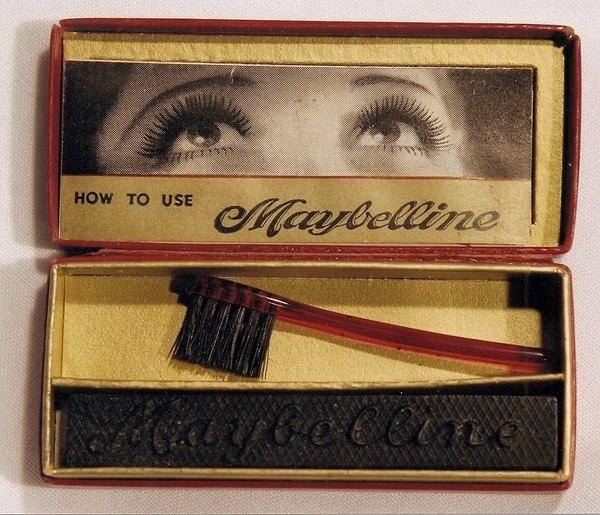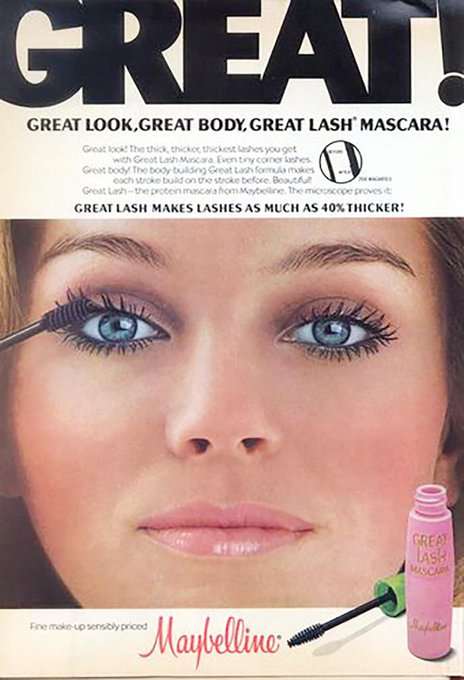They also used singed bottle corks and the blackish juice of elderberries. In 1872, French perfumer-entrepreneur Eugène Rimmel invented the world’s first commercially available mascara. His lash-plumping formula was simple: petroleum jelly and coal dust. (Rimmel, now owned by global cosmetics giant Coty Inc., still produces a variety of popular mascaras today.
Applying Rimmel’s messy mascara was nothing to blush at. Users first dampened a rigid brush that looked like a mini toothbrush, then rubbed it across a gumstick-sized rectangle of a pigmented “cake.” It was little more than a hunk of black soap. With running water often tough to come by at the time, women sometimes used saliva to wet the brush, earning mascara the nickname “spit black.”
By the turn of the 20th century, the concept of mascara as a beauty enhancer had lashed out and taken hold across the pond, here in the United States, only we were still making it on our own. That is until in 1915 in Chicago. There, a scrappy, 19-year-old entrepreneur and Kentucky farm boy named Thomas Lyle Williams watched with curiosity as his older sister Maybel, who’d burned her eyelashes and eyebrows in a kitchen accident, dabbed grime on her eyelashes. She concocted the homespun mascara from what everyone else did at the time -- coal-dust ashes, burnt cork and petroleum jelly. Seeing dollar signs in Maybel’s smoky eyes, Williams borrowed his buddy’s chemistry set and got busy tweaking her formula, which she dubbed “the secret of the harem.”
Williams’ first recipe flopped. When Maybel tried the oily blend of cottonseed oil, carbon black and Vaseline, it bled down into her eyes and stung like heck.
He went back to the drawing board, hopped on a train to Detroit and ordered a fresh round of supplies from Parke-Davis, a wholesale drug supplier. (Also on a historical note, America’s oldest and once largest drugmaker, Parke-Davis is now a subsidiary of the pharmaceutical giant Pfizer.) Determined to be successful, Williams hunkered down in a boarding house with a few family members and melted the supplies he scored down into black beauty gold. The second time was the charm.
Next freshly bankrolled with a $500 loan from his older brother, Williams officially launched his finished product, Lash Brow Line. It was an overnight sensation with the locals. William changed the mascara’s name to Maybelline, a catchy combination of Maybel and Vaseline, put his sister’s face on the packaging and an iconic American brand was born. The company sold the mascara by mail order at first, then later in stores throughout the country and, eventually, the world. Hollywood was no exception, where ultra-glamorous silent film stars took to the lash darkener, pushing it further into the mainstream.
The Maybelline brand, now owned by French beauty products conglomerate L'Oréal, has risen to become the world’s leading cosmetics brand. To this day, the multibillion dollar household brand sells one of its trademark green and pink packaged Great Lash mascara tubes every two seconds. Not too shabby for a business founded on a hope, a prayer and glorified gelatinous gunk.
All in all, the extraordinary rise and staying power of mascara through the ages is something to bat your lashes at indeed, tears, rain or shine.
https://www.entrepreneur.com/topic/maybelline
https://www.entrepreneur.com/topic/maybelline





